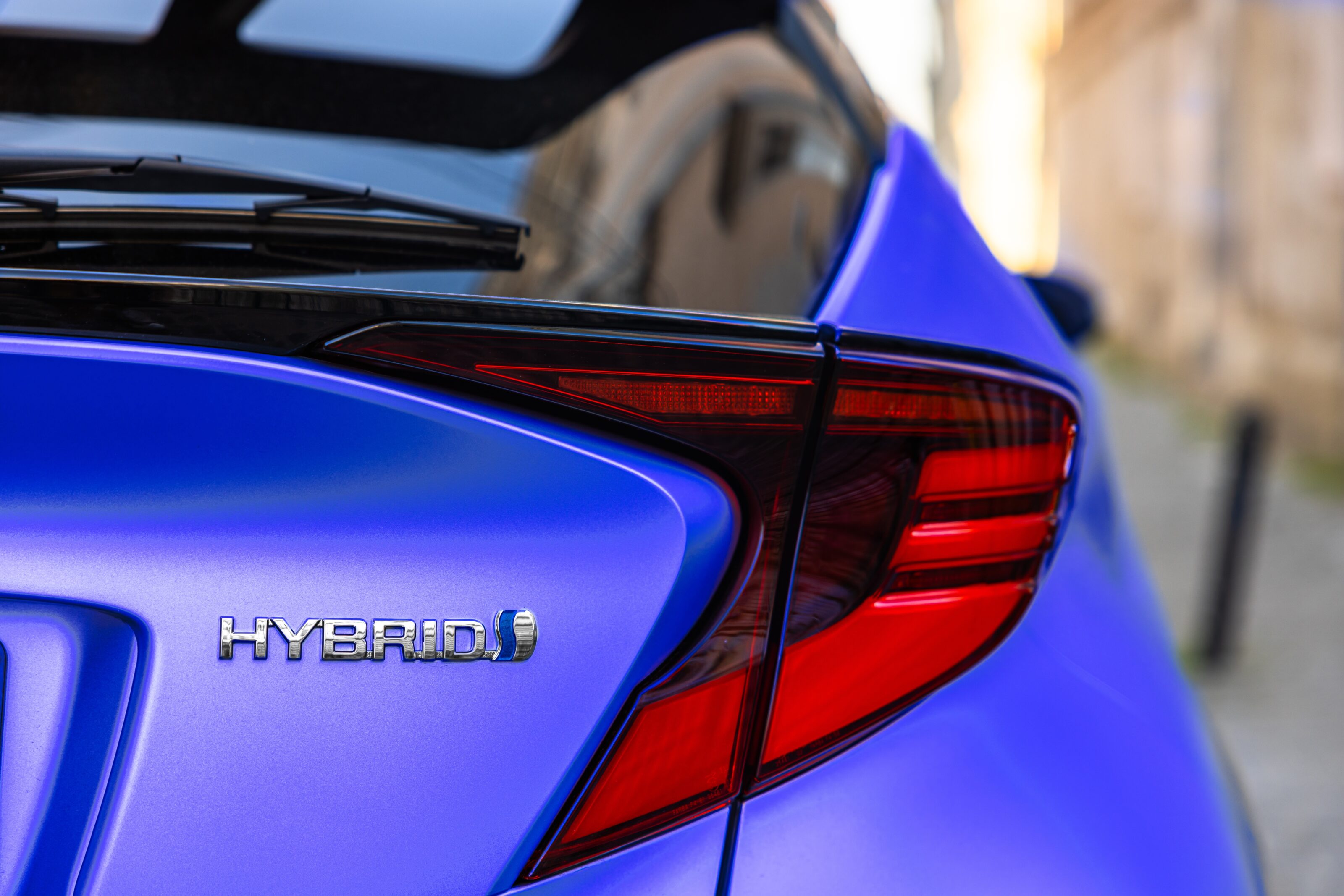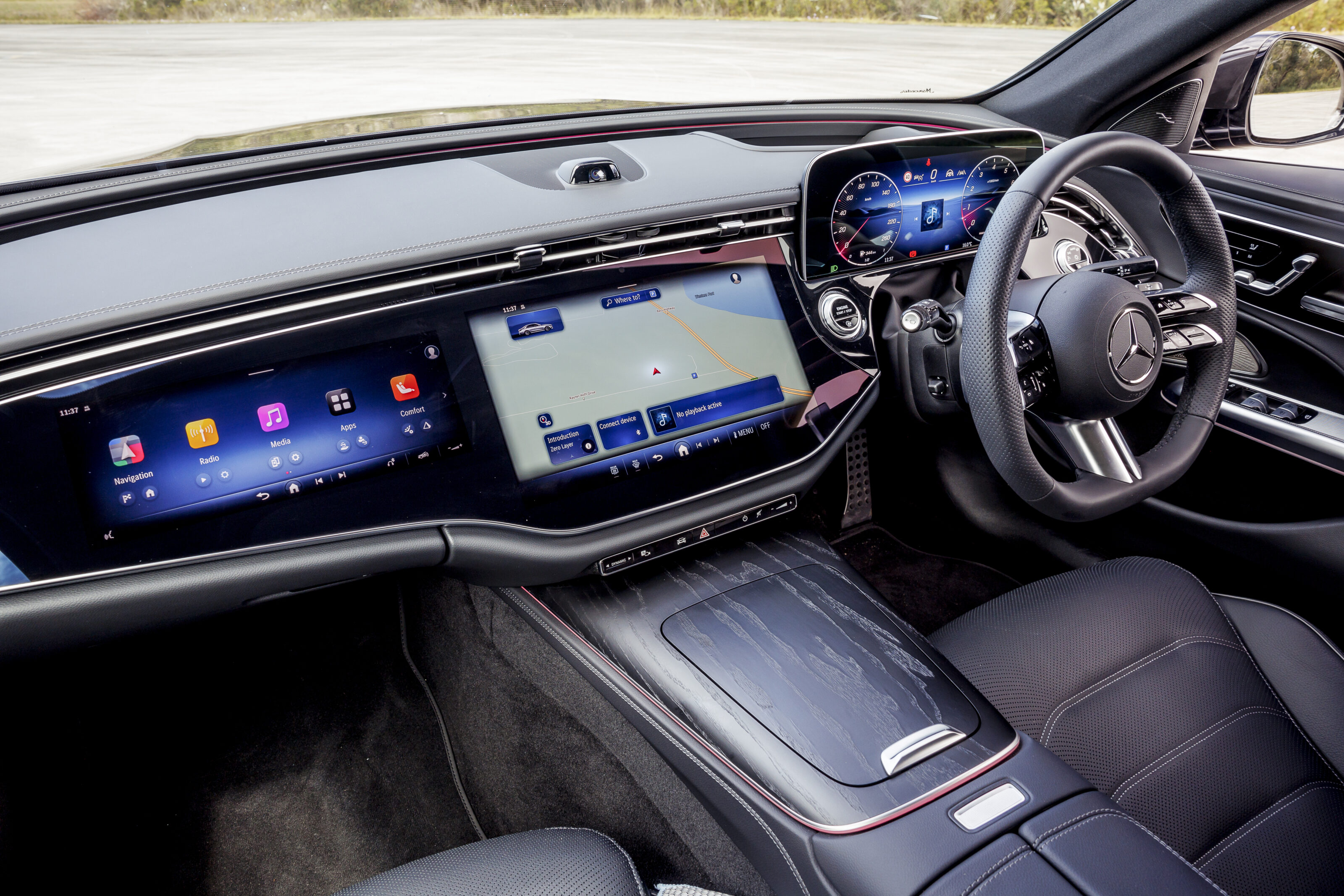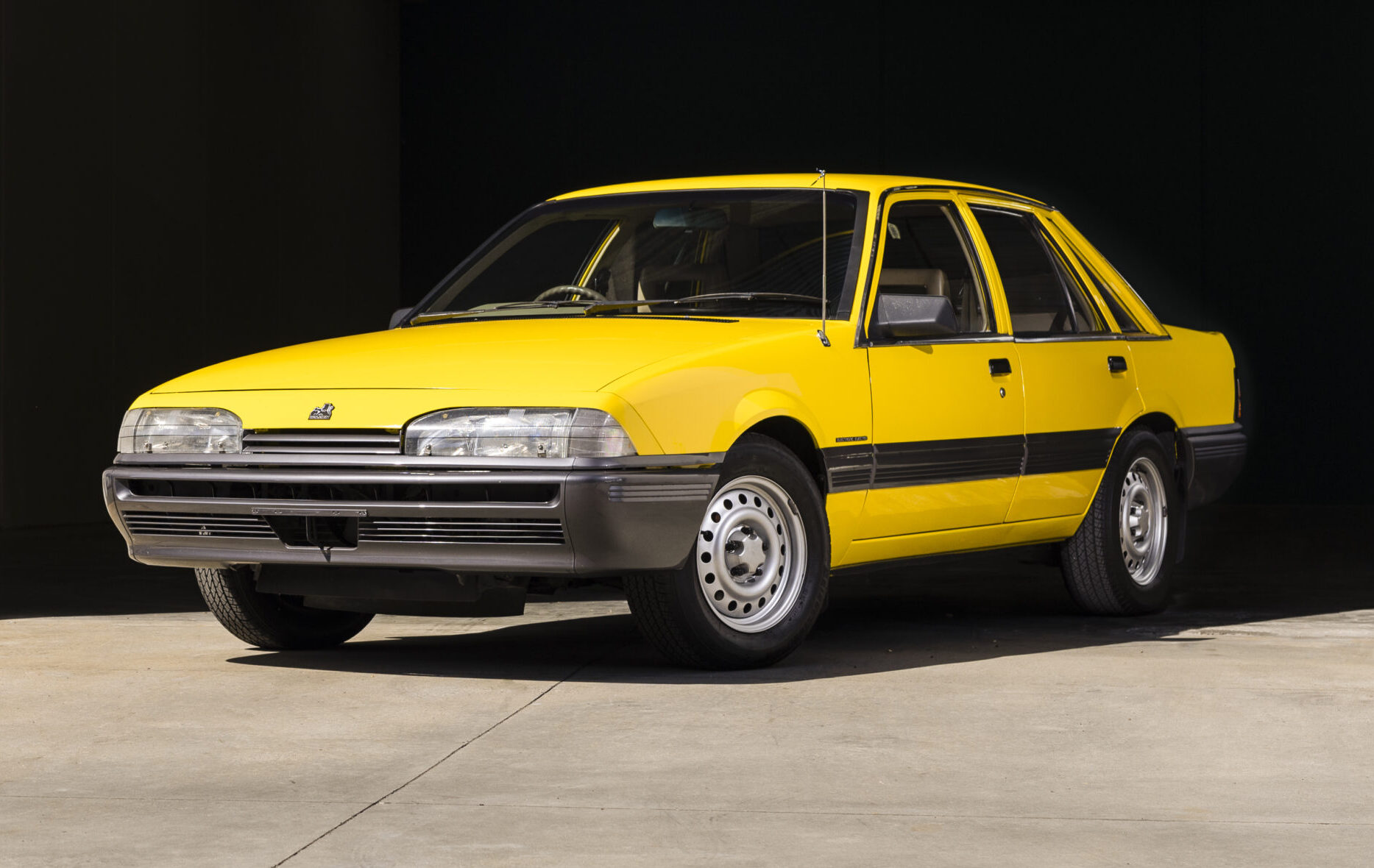Standing by the pit wall, a little white speck rounds the bottom corner of Wakefield Park and begins to wind itself towards me.
This article was originally published in the May 2011 issue of MOTOR.
I can hear the engine sucking in 351 cubic inches of air 50 times a second. The headlights dazzle me every time the car changes gear, the clutch slams home and that bluff nose rises against gravity and all logic one more time.
Now in fourth gear, the white missile blazes past, a wall of mangled air convincing me to take a half-step backwards.
It’s none other than Moffat in nothing less than a Phase III GT HO. Hang on a sec: Moffat? Phase III? What’s going on here? Has Wakefield Park been shipped back in time four decades?
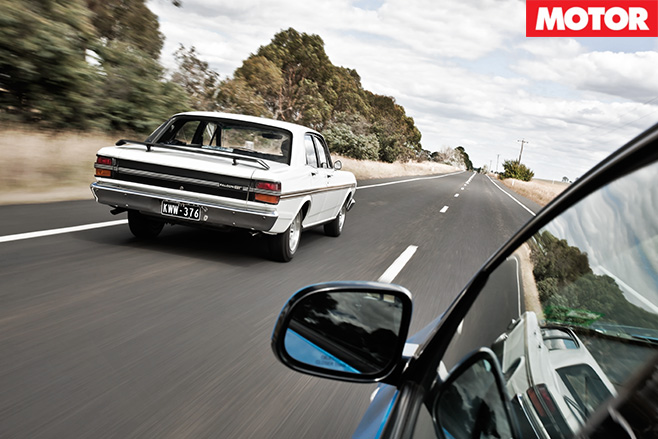
Now, see, this is interesting. The Ford Falcon has survived all this time (for now) and a new generation of Moffatry has stepped up to do the hot laps these days. Question is: how far have we really come?
Well, I’m not about to start comparing Moffat The Elder with James The Son, but there are some valid comparisons to be made when it comes to the Falcon package. Specifically, how good was (and is) the GT HO really? And, can a most basic ‘sporting’ Falcon make the most of 40 years of research and development and keep the old girl honest?
I mean, we’re constantly hearing about how good modern cars are; how even a cooking model can knock off the fastest, gruntiest of the old stagers. So how’s about we put it to the test once and for all.

So why an XR6? Well, right now, bent-eight XR8s are on hiatus and the Turbo’s too powerful for fair play. Ditto the blown-V8 FPV gear. But crunch the raw data, and a non-turbo FG makes enticing competition.
See, its 4.0 six makes 195kW and 391Nm. Factor in the car’s 1728kg weight and you’ve got 113kW per tonne. So says Ford Oz.
The original claim for the GT HO was 224kW and 515Nm, though an army of Hoey-lovers will tell you it actual made more output. Weight? Just 1542kg. That’s a dominant 146kW per tonne. And plenty of scope for the old car to peg back its deficits in chassis and braking technology.
The dragstrip…
Okay, figuring we’d ease him into things, we let James loose in the new car first up at Sydney Dragway. You know, to get into a groove. And with the user-friendly auto ’box, it wasn’t long before he was cranking out consistent 14.8 second runs with a terminal velocity around the 153km/h mark. This is not bad for something that is a money meter and dome-light away from being hailed at the next corner.
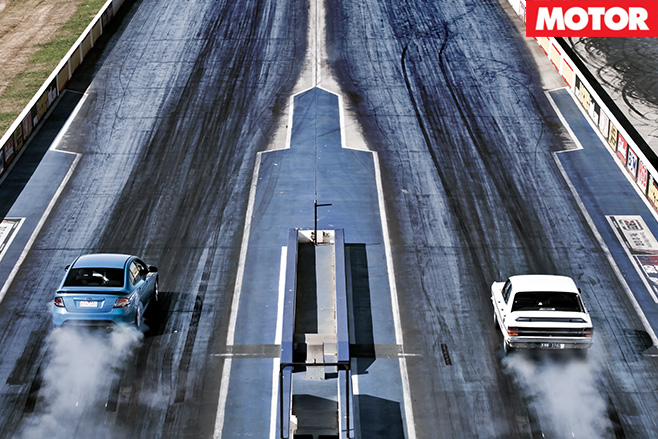
The gearshift in the Toploader four-speed feels like you’re setting a bear trap, and refuses to be rushed. The clutch is a bit more forgiving, but the real booby-traps are the 20-year-old Pirelli radials, whose grip on bitumen mirrors Charlie Sheen’s post-lunch hold on reality.
So it takes James a few passes to get it right, but before long he’s tantalisingly close to the FG’s 14.8sec best. And finally, it happens; Moff cracks it for a 14.8 at 156.2km/h.
Now, to those who hold that 400m of sticky hotmix is the end of any performance argument, some bad news. Here’s why. The most-powerful car doesn’t always win. In fact, the fastest car doesn’t always win these match-ups either. Ultimately, the car with the best combination of traction, torque, weight transfer and driveability will likely come up trumps in a drag race. And then there are tied results like this one.
See while, nought to 100 in either car comes up in 6.8sec and the quarter-mile in 14.8, it’s just not that simple. The biggest difference on the face of it is the terminal speed, with the old girl shading the FG by a couple of kays. Given that they both blitz 100km/h in the same time – suggesting a decent hook up in both cases – what’s going on with the Phase III’s extra terminal speed?

It’s the same every gear. The Phase III pulls out half-a-car length and then surrenders it during the inevitable, clumsy gearchange.
You can feel the FG has nothing like the Phase III’s grunt. It’s as plain as day on the drive from Sydney down to Goulburn’s Wakefield Park.
Race circuit…
Cars like the GT HO were, of course, designed as homologation specials. And, therefore, they were designed to do one thing; win races. So if the HO was going to shine in this contest, it’d be at the track, right?
Erm, maybe, but let’s also bear in mind those late-Jurassic Pirellis and the fact that braking was never really a HO long suit, even in its day.

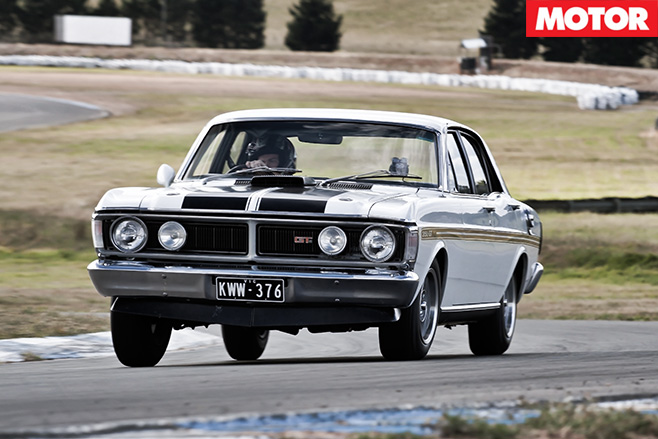
With all that in mind, then, nobody was too surprised to see the Phase III seven seconds adrift of the FG, though at least two of those seconds would be down to those tyres.
You could see the deficit in the data. The FG’s v-max during the lap was 161.8km/h, while the GT HO, even with its superior squirt, just wasn’t exiting the corners with as much pace, recording a peak of 154.4km/h.
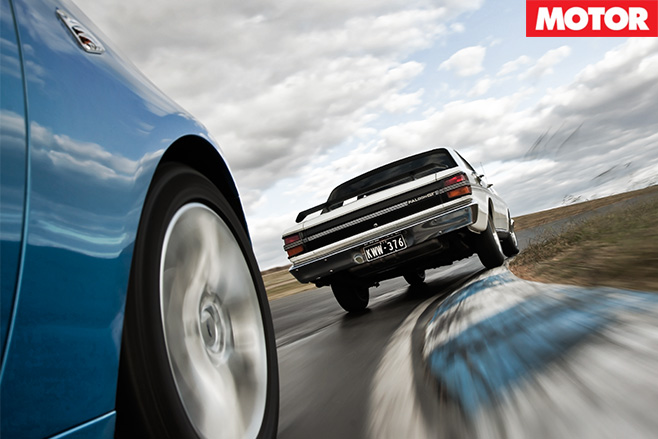
So, how far have we come in 40 years? A certain distance, to be sure, but maybe not as far as you might have thought in some areas.
And in any case, you can throw all the numbers in the world right into the nearest skip when it comes to the emotional attraction of both cars, because I sure as hell know which one I’d have rather gone home with (and it ain’t blue in colour).
And the Moffat motor-racing dynasty forty years on? Set to go from strength to strength, by the look of things.
Specs
| u00a0 | u00a0FORD XY FALCON GT HO | FORD FG FALCON XR6u00a0 |
| Body | 4-door, 5 seat sedanu00a0 | 4-door, 5 seat sedanu00a0 |
| Drive | rear wheelsu00a0 | rear wheelsu00a0 |
| Engine | 90-degree V8, OHV, 16vu00a0 | in-line 6, DOHC, 24v |
| Material | iron head/iron block | iron head/iron block |
| Bore/Stroke | 101.6 x 89.0mmu00a0 | alloy head/iron block |
| Capacity | 5766cc | 3984cc |
| Compression | 11.5:1u00a0 | 10.3:1 |
| Power | 224kW @ 5400rpmu00a0 | 195kW @ 6000rpm |
| Torque | 515Nm @ 3400rpmu00a0 | 391Nm @ 3250rpm |
| Redline/cut | 6000/6150rpmu00a0 | 5500/6400rpm |
| Fuel tank | 98 octane/ 163 litreu00a0 | 98 octane/68 litres |
| Kerb weight | 1524kgu00a0 | 1728kgu00a0 |
| POwer-to-weight | 146kW/tonneu00a0 | 113kW/tonne |
| Transmission | 4-speed manualu00a0 | 6-speed automatic |
| Ratios | 2.32/1.93/1.36/1.00u00a0 | 4.17/2.34/1.52/1.14/0.87/0.69 |
| Final drive | 3.25 (LSD) | 2.73 |
| Suspension | double A-arms, coil springs, anti-roll bar (f); live axle, leaf springs, dampers, anti-roll bar (r)u00a0 | double A-arms, coil springs, anti-roll bar (f); multi-links, coil springs, anti-roll bar (r) |
| L/W/H | 4689/1869/1397mm | 4970/1868/1433mm |
| Wheelbase | 2819mm | 2838mm |
| Tracks(f/r) | 1499/1486mm | 1583/1598mm |
| Steering | recirculating ball | power rack and pinion |
| Turning circle | 11.2m | 11.0m |
| Brakes | 286mm discs, single-piston calipers (f); 254mm finned drums | 298mm ventilated discs, twin-piston calipers (f); 303mm solid discs, single-piston calipers (r); |
| Wheels | 15 x 7.0-inch, alloy | 17 x 8.0-inch, alloy |
| Tyres | Pirelli P5 | Dunlop SP Sport 01 |
| Size | 205/70VR15u00a0 | 245/45R17 95Wu00a0 |
| Price | $5302 (1971) | $43,990 |
| As tested | $500,000 (estimated) | $45,840 |
Numbers down the strip
| u00a0 | FORD XY FALCON GT HOu00a0 | FORD FG FALCON XR6u00a0u00a0 |
| 0-10km/h | u00a00.49sec | 0.37secu00a0 |
| 0-20km/h | 1.00secu00a0 | 0.83secu00a0 |
| 0-30km/h | 1.53secu00a0 | 1.33sec |
| 0-40km/h | 2.14secu00a0 | 1.89secu00a0 |
| 0-50km/h | 2.71secu00a0 | 2.44secu00a0 |
| 0-60km/h | 3.28secu00a0 | 3.08secu00a0 |
| 0-70km/h | 3.86secu00a0 | 3.98secu00a0 |
| 0-80km/h | 5.24sevu00a0 | 4.86sec |
| 0-90km/h | 5.99secu00a0 | 5.76secu00a0 |
| 0-100km/h | u00a06.77sec | 6.75secu00a0 |
| 0-110km/h | u00a07.62sec | 7.92secu00a0 |
| 0-120km/h | u00a09.38sec | 9.46sec |
| 0-130km/h | 10.54secu00a0 | 10.86sec |
| 0-140km/h | 11.70secu00a0 | 12.37sec |
| 0-150km/h | 13.00secu00a0 | 14.04sec |
| 0-400m | 14.81 @ 156.26km/h | 14.85 @ 153.27km/h |
| 80-120km/h (3rd-6th) | 4.11sec | 4.50sec |
| 100km/h-0u00a0 | 64.65m | 41.05m |



